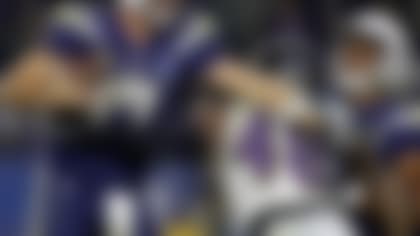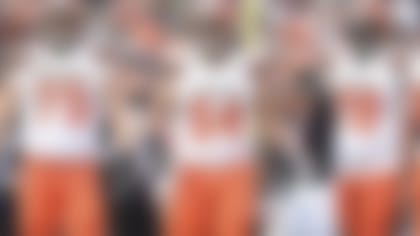When free agency arrives, most fans aren't hoping their teams shell out truckloads of money on the hottest prospect at guard. Why? Well, because it's not sexy. From a merchandising perspective, it doesn't sell jerseys, either.
But what it does produce, usually, is wins.
Look no further than the line of the Oakland Raiders, who are spending nearly $173 million on their offensive line in terms of total contract value for the starting five. After drafting Derek Carr, the Raiders quickly made the men up front a priority in order to insure their investment in the gunslinger.
Oakland signed tackle Donald Penn (two years, $11.9 million) and drafted Carr and guard Gabe Jackson (five years, $55 million deal signed in 2017) in 2014, then signed center Rodney Hudson (five years, $44.5 million) away from the division rival Chiefs in 2015, and inked guard Kelechi Osemele (five years, $58.5 million) in 2016. All four of the aforementioned linemen are starting, with rookie Vadal Alexander (four years, $2.416 million) slotted to start at right tackle, and veteran Marshall Newhouse (two years, $3.5 million) also available to play the same position.
The results: $172.9 million invested (third-most in the NFL), 4.4 yards per carry on the ground (sixth in the NFL), 253.2 yards per game through the air (13th in the league), just 18 sacks allowed (best in the league), and 12 wins in their first season together in 2016.
While we expect more of the same from a handsomely compensated offensive line in Oakland -- which could become even more expensive if Penn gets his desired payday -- the same can't exactly be said for the reigning unit of the year in Dallas.
Before you take up your keyboards and sling vitriolic condemnation in my direction, allow me to explain the minor differences that make this a marginally unknown element to the Cowboys' 2017 campaign.
First: The retirement of Doug Free and departure of Ronald Leary have sapped this unit of some of its depth, which was a big part of why it was so effective last season. Sure, there's cornerstone Tyron Smith at left tackle, cerebral guard Zack Martin and reliable center Travis Frederick; but what about left guard, the position vacated by Leary (and La'El Collins, who has since moved to right tackle to replace Free)?
Dallas is turning to Jonathan Cooper, who was once a first-round pick of the Arizona Cardinals (seventh overall in 2013), but washed out of the desert, New England and Cleveland before landing in Dallas. It sounds as though he's finally started to hit his stride as a Cowboy, but is it true development, or a product of him playing alongside four excellent teammates?
Much of Dallas' effective ground attack is predicated on how well these linemen work in tandem, in both zone blocking and on power plays that require double teams and chips to second level. Should Cooper struggle, it will stand out sooner than later. But he's also it a situation where, if he executes his basic responsibilities properly, could reach a height originally envisioned for him by Arizona back in 2013. We aren't saying Cooper is the difference between a 12-win and seven-win Cowboys season (he's far from that), but his possible success could again make the unit the league's best.
On the money side, Dallas drafted the majority of its talent. In fact, of the five starters, only Cooper wasn't a selection of the Cowboys. Martin is still waiting on his big contract, but even without his payday, Dallas is still spending the second most in the league on its line (newsflash: it's worth it), opening the coffers to dole out $180.367 million in contracts to its starting five. Smith leads the way with an eight-year, $97.6 million contract signed in 2014. Collins just signed a two-year extension in July worth $15.4 million that reflected his actual performance instead of his undrafted status (which never should have happened to the first-round prospect). Frederick is in Year 2 of a six-year, $56.4 million deal. Cooper is on a prove-it deal, making $2 million on a one-year deal.
We know the results here: rookie sensations at running back and quarterback, 149.8 yards per game on the ground, 28 sacks surrendered (T-7th in the NFL), a division crown and plenty of reason for optimism moving forward.
Speaking of reasons for optimism, there weren't many in Cleveland last season. When you go 1-15, that tends to be the case. But the Browns decided to finally use some of that cavernous cap space in 2017, bolstering an offensive line that was surprisingly effective on the ground but downright putrid at protecting its many quarterbacks, and perhaps there is a reason to look beyond the seemingly perpetual overcast skies over Cleveland.
Cleveland did something it hadn't done in a decade: It pillaged Cincinnati for its best lineman, signing guard Kevin Zeitler away from the Bengals on a five-year, $60 million deal, the most for an NFL guard. The Browns also snatched center J.C. Tretter away from the Packers on a three-year, $16.75 million deal, and secured standout guard Joel Bitonio on a five-year, $51.2 million extension, surprisingly giving Bitonio the team's highest cap number, edging linebacker Jamie Collins by $137,813. If that doesn't show how Cleveland values its offensive line (and its collective job to protect the passer), nothing will.
The Browns also worked out Cameron Erving at tackle, but after realizing it was a doomed effort, still managed to acquire a fifth-round pick for him in a trade with Kansas City. And if you're wondering about Cleveland's future Hall of Famer at left tackle, Joe Thomas, he's in the second to last year of an eight-year, $80.5 million contract.
The point in Cleveland is obvious: No longer will management and coaches stand pat while their quarterbacks are beaten into the turf in some kind of twisted weekly ritual. There's also the added bonus for the running game, which figures to be effective, though the bar is surprisingly (but also somewhat inaccurately) high after Cleveland averaged 4.9 yards per carry (second best in the NFL) in 2016. Isaiah Crowell came 48 yards shy of 1,000 last season on one of the worst teams of the last decade. He should be a safe pick to break that mark in 2017.
The total price tag in Cleveland for the rebuild up front: an eye-popping, jaw-dropping $210.528 million, the highest in the league. If the unit can cause fans to react how they might after seeing this bill on Sundays, and if the group can keep the same quarterback upright for 75 percent of the season (we're not asking for 16 starts here), then it will be worth every penny for the Browns.











